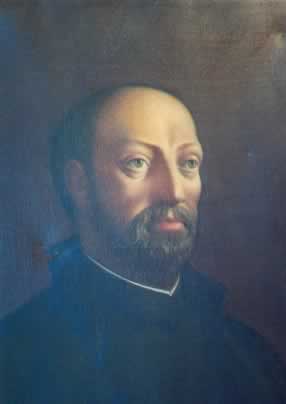Jean de Brébeuf, author of the Huron Relation for 1635, was born at Conde-sur-vire, in Normandy, March 25, 1593. His ancestry seems to link him with William the Conqueror and St. Louis of France and even with the English Earls of Arundel. There is really very little we know of his immediate family. His father was Gilles de Brébeuf. We hear of two nephews: George, a minor poet, and Nicolas, a prior of a monastery near Caen.
 Brébeuf worked primarily among the Huron Indians in Quebec, Canada. He was born near Saint-Lo, Normandy, and ordained a Roman Catholic priest in 1622. In 1625 he arrived in the New World with the French explorer Samuel de Champlain. When the village of his Jesuit mission was taken by the Iroquois, Brébeuf and the French Jesuit missionary Gabriel Lalemant, his associate, were made prisoners and tortured to death in 1649. The tortures they endured are considered among the most hideous in the entire history of martyrdom.
Brébeuf worked primarily among the Huron Indians in Quebec, Canada. He was born near Saint-Lo, Normandy, and ordained a Roman Catholic priest in 1622. In 1625 he arrived in the New World with the French explorer Samuel de Champlain. When the village of his Jesuit mission was taken by the Iroquois, Brébeuf and the French Jesuit missionary Gabriel Lalemant, his associate, were made prisoners and tortured to death in 1649. The tortures they endured are considered among the most hideous in the entire history of martyrdom.
His memory is cherished in Canada more than that of all the other early missionaries. His heroic virtues, manifested in such a remarkable degree at every stage of his missionary career, his almost incomprehensible endurance of privations and suffering, and the conviction that the reason of his death was not his association with the Hurons, but hatred of Christianity, has set on foot a movement for his canonization as a saint and martyr. An ecclesiastical court sat in 1904 for an entire year to examine his life and virtues and the cause of his death, and the result of the inquiry was forwarded to Rome. Brébeuf and seven other Jesuits, known collectively as the Jesuit North American Martyrs, were canonized in 1930. His feast day is October 19th.
Brébeuf's Instructions to the Missionaries
In 1637, Father Jean de Brébeuf drew up a list of instructions for Jesuit missionaries destined to work among the Huron. These reflect his own experience and a genuine sensitivity toward our people.
- You must love these Hurons, ransomed by the blood of the Son of God, as brothers.
- You must never keep the Indians waiting at the time of embarking.
- Carry a tinder-box or a piece of burning-glass, or both, to make fire for them during the day for smoking, and in the evening when it is necessary to camp; these little services win their hearts.
- Try to eat the little food they offer you, and eat all you can, for you may not eat again for hours.
- Eat as soon as day breaks, for Indians when on the road, eat only at the rising and the setting of the sun.
- Be prompt in embarking and disembarking and do not carry any water or sand into the canoe.
- Be the least troublesome to the Indians.
- Do not ask many questions; silence is golden.
- Bear with their imperfections, and you must try always to appear cheerful.
- Carry with you a half-gross of awls, two or three dozen little folding knives (jambettes), and some plain and fancy beads with which to buy fish or other commodities from the nations you meet, in order to feast you Indian companions, and be sure to tell them from the outset that here is something with which to buy fish.
- Always carry something during the portages.
- Do not be ceremonious with the Indians.
- Do not begin to paddle unless you intend always to paddle.
- The Indians will keep later that opinion of you which they have formed during the trip.
- Always show any other Indians you meet on the way a cheerful face and show that you readily accept the fatigues of the journey.
SOURCES: The Catholic Encyclopedia,
Huron Relations on the World Wide Web, and
The 1999 Canadian Encyclopedia.
|


 Brébeuf worked primarily among the Huron Indians in Quebec, Canada. He was born near Saint-Lo, Normandy, and ordained a Roman Catholic priest in 1622. In 1625 he arrived in the New World with the French explorer Samuel de Champlain. When the village of his Jesuit mission was taken by the Iroquois, Brébeuf and the French Jesuit missionary Gabriel Lalemant, his associate, were made prisoners and tortured to death in 1649. The tortures they endured are considered among the most hideous in the entire history of martyrdom.
Brébeuf worked primarily among the Huron Indians in Quebec, Canada. He was born near Saint-Lo, Normandy, and ordained a Roman Catholic priest in 1622. In 1625 he arrived in the New World with the French explorer Samuel de Champlain. When the village of his Jesuit mission was taken by the Iroquois, Brébeuf and the French Jesuit missionary Gabriel Lalemant, his associate, were made prisoners and tortured to death in 1649. The tortures they endured are considered among the most hideous in the entire history of martyrdom.